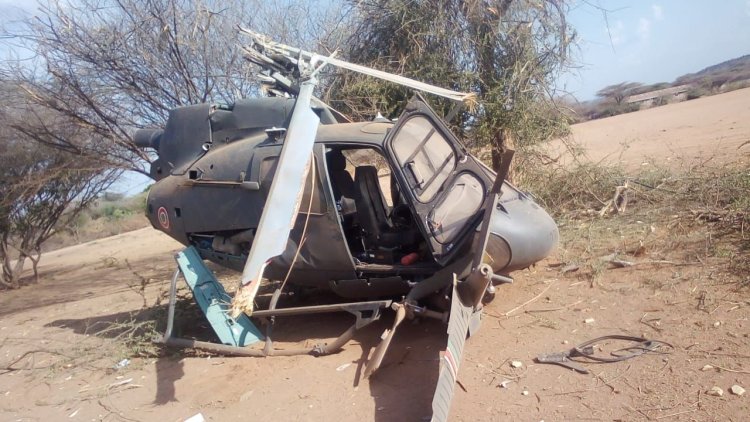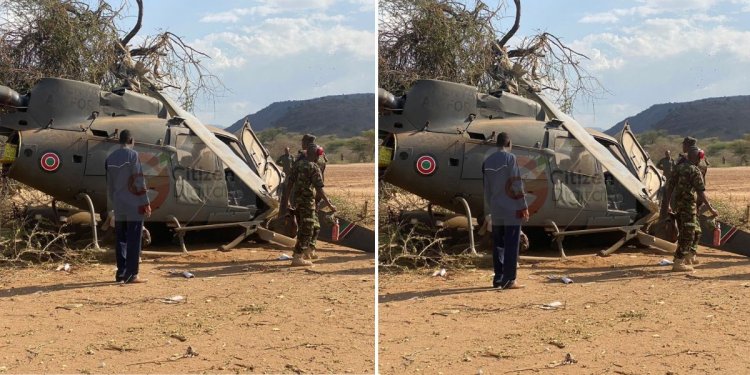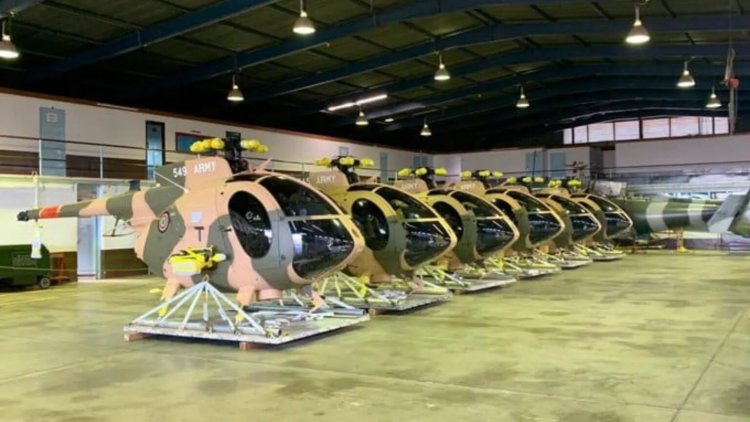Kenya Air Force Chopper Bound For Nairobi Crashes
All the passengers on board the chopper however survived.

A Kenya Air Force chopper crashed on Thursday, July 20 while taking off on its way to Nairobi from the Rift Valley region.
According to a notice from the Kenya Defence Forces (KDF), the helicopter, a Eurocopter Fennec, crashed after hitting a tree while taking off from Chemlingot Stadium.
All the passengers on board the chopper as well as the crew however survived. They were on their way to Nairobi from an official duty when the chopper developed mechanical challenges and crashed.

Kenya Air Force chopper that crashed after take off at Chemlingot Stadium on Thursday, July 20, 2023. /SETH OLALE
"This evening, a Kenya Air Force, Fennec helicopter, while taking off from Chemlingot stadium en route to Nairobi, hit a tree and crashed," stated KDF in part.
The KDF also assured members of the public that their crew will make it to full recovery since those involved in the accident were receiving adequate medical attention.
"All passengers disembarked safely and are in stable condition," added KDF.
Reports indicated that the chopper was carrying officials who were part of the entourage accompanying Defence Cabinet Secretary (CS) Aden Duale on a security tour of the volatile region.
What Happens During An Aircraft Crash Investigation?
At the beginning of the inquiry, the investigator-in-charge, usually an investigator from the lead country’s aviation safety board, coordinates with local first responders to determine what hazards may be present at the crash site and ensures safe access for investigators to visit the wreckage.
Dangerous debris could include hazardous cargo, flammable or toxic materials and gases, sharp or heavy objects and pressurized equipment. Human remains or blood from injured victims may also pose dangers of disease, meaning investigators must protect themselves against viruses, bacteria or parasites.
The investigators on the scene take photos and videos of the wreckage and collect as much physical evidence as they can. They also conduct interviews with eyewitnesses and draw charts showing the debris field and any indications of how the aircraft hit the ground, such as the angle of impact, the distribution of debris and other details.
Investigators also collect all the documents related to the aircraft, its crew and its recent flights for forensic analysis.
An early priority is locating the crucial evidence in what is often called the aircraft's “black boxes.”
There are two kinds, that is the flight data recorders keep track of flight parameters such as altitude, heading, instrument readings, power settings and flight control inputs. The cockpit voice recorders store all communications with the aircraft, including from air traffic controllers, and record any conversations among cockpit occupants and other audible cockpit sounds for the two hours leading up to the crash.
All that information lets analysts reconstruct, and even create video simulations of, the last moments of the plane’s flight.
Other teams look at technical aspects that might have contributed in any way to the crash. They look at air traffic control activity and instructions, weather, human performance issues like crew experience and training, maintenance records, emergency response, safety equipment, aircraft performance and subsystems.
Oftentimes, the goal of an air crash investigation is to determine the cause of the accident and to make recommendations to prevent similar accidents from happening in the future.
KDF will seek to establish if the crash was a result of human error, which is the most common cause of air crashes. It can include pilot errors, crew coordination errors, and passenger interference.
On Thursday, June 24, 2021, 10 Kenya Air Force personnel died while 13 others sustained injuries after the aircraft they were travelling in crash-landed in Oltepesi, Kajiado West during a routine training of special forces.
This was one of the few instances KDF chopper crashes have led to deaths, despite chopper crashes occurring on past occasions.


 admin
admin 




